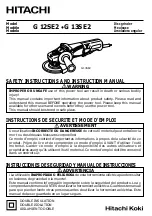
8
FIG. 5
M
N
L
K
J
C
FIG. 4
K
J
N
L
J
K
FIG. 6A
J
FIG. 6B
N
L
K
4. Screw the threaded clamp nut (N) onto the spindle (K) as shown in Figure 6:
a. The ring on the threaded clamp nut (N) must face towards the disc when
fitting a grinding disc (Fig. 6A);
b. The ring on the threaded clamp nut (N) must face away from the disc when
fitting a cutting disc (Fig. 6B).
When using the D28495-XE or the D28498-XE grinder for cutting metal or masonry, a
Type 1 guard MUST be used. Type 1 guards are available at extra cost from D
E
WALT
distributors.
NOTE:
Please refer to pages 9–10
I
G
D
F
FIG. 3
H
for information on choosing the
correct guard, flanges and
accessories.
1. Place the angle grinder on a
table, spindle up.
2. Release the clamping lock (F)
and hold the guard (D) over
the tool as shown.
3. Align the lugs (G) with the
notches (H).
4. Press the guard down and
rotate it to the required
position.
5. If required, increase the
clamping force by tightening
the screw (I).
6. Tighten the clamping lock.
7. To remove the guard, release
the clamping lock.
CAUTION:
If the guard cannot be tightened by the adjusting screw, do not use the
tool. To reduce the risk of personal injury, take the tool and guard to a service center
to repair or replace the guard.
Fitting and Removing a Grinding or Cutting Disc (Fig. 4–6)
WARNING:
Do not use a damaged disc.
1. Place the tool on a table, guard up.
2. Fit the backing flange (J) correctly onto the spindle (K, Fig. 4).
3. Place the disc (L) on the backing flange (J, Fig. 5). When fitting a disc with a
raised center, make sure the raised centre (M) is facing the backing flange (J).


































